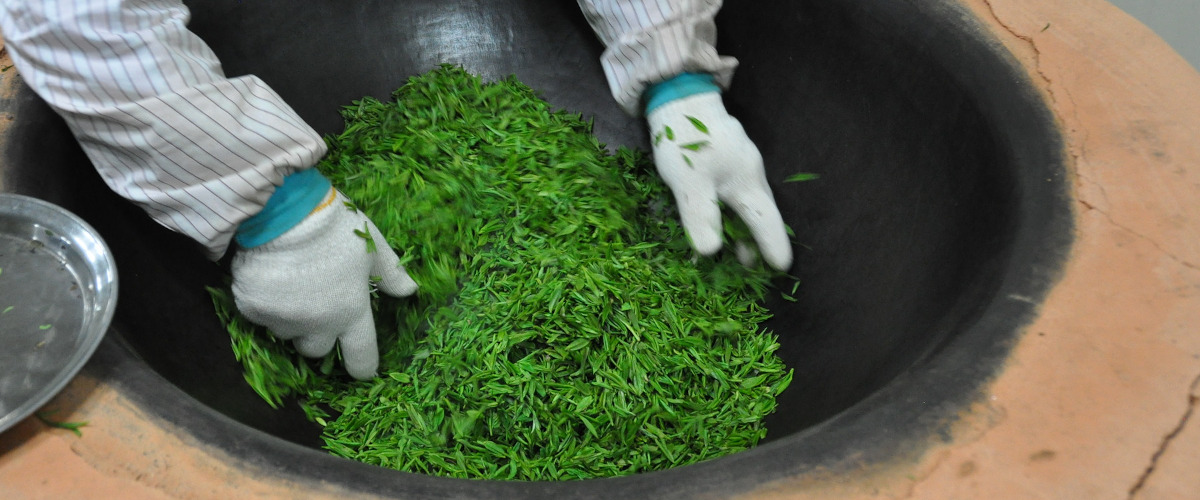
This is green tea
All 'real' tea comes from the tea bush, camellia sinensis, whether it's black, green or white tea. Although the plant comes in different varieties, cultivars, it is the post-harvest process that determines which variety it will be. Cultivation of finer green teas takes place mainly in China, Japan and Korea, but especially industrial production is also carried out in many other countries. Green tea comes from the tea bush, and is then processed after picking, and it is this process that we will explain here!
The harvest
There is of course a lot to do before the harvest. You have to choose the location, the right variety of tea plant, you have to plant, fertilize, prune and so on. Now, assuming all that is done, it's time to harvest.
Harvesting normally takes place in spring, from late March to early June, depending on local conditions and the type of tea to be produced. In China, much of the picking is done by hand, while in Japan, harvesting is more often done by machine. Naturally, this affects the price. For finer varieties, picking is done by hand, and it may be that only leaf buds are picked, or a bud and a leaf.
Here we visit a Chinese tea plantation where Bi Luo Chun is grown. The leaf bud and one leaf must be plucked, no more and no less. When picking correctly, the leaves should be broken and not pinched off. If you pinch the leaves, you damage the cell walls, liquid escapes and oxidizes. The green tea then has a slightly different taste. It's the same reason why master chefs usually recommend that you tear your lettuce leaves, not cut them.
Airing and weeding
The harvested leaves are now allowed to lie down for a while, a process known as withering. The leaves lose water, making them softer for the next steps. Sometimes, the leaves are also gone through once more, to make sure that a bud and a leaf have been picked, and that no withered or broken leaves have been left behind. It takes between 10 000 and 60 000 leaf buds to make 1 kg of tea. So producing premium green tea is labor-intensive.
Heating up
The leaves are now heated, and in simple terms, this is what makes it green tea. In China, a hot wok is used, around 180°C, and the leaves are 'fried' so to speak. To the uninitiated, it looks like they're just whisking the leaves around in the wok, but it's a series of different steps that are done depending on where you are in the process. Only a trained person should do this, otherwise you risk damaging the leaves.
In Japan, the heating is instead done with steam for a very short time. What happens is that an enzyme in the leaves (polyphenol oxidase) is destroyed. This enzyme otherwise allows the leaves to oxidize. It is the same substance found in apples, and causes them to darken quickly when cut. By degrading the enzyme, the leaves remain green.
Rolling/shaping
We're trying to describe a lot of different traditions at the same time. When making Long Jing, the leaf feather is removed, and there are small tufts that are removed. When making bi luo chun, they are left on the leaves instead, causing them to sink when placed in hot water. In Chinese tradition, this step is intertwined with the previous one. The leaves are shaped according to tradition. It can be needle-shaped, flat lance-shaped, screwed in spiral, or round. Machines that are more efficient at rolling the blades are sometimes used here.
Here is a picture of one such small machine. The tea leaves are put into a cylinder. A lid (barely visible at the top) presses the leaves down. Under the cylinder is a table that performs a circular motion. This is how the leaves are rolled.
Drying & cleaning
The leaves must of course be dried before packing. This can be done in a wok or drying oven, or spread out on a table. After drying, the leaves are cleaned, e.g. burnt leaves are removed. It also removes dust from the leaf feathers and residues that have fallen off the leaves. Green tea is often brewed in glasses, and removing dust makes it look more appetising. But it also affects the taste.
Finishing - Roasting
Some green teas undergo an additional roasting as the final step. This gives a particularly aromatic, almost bread-like flavor. There are also hard-roasted teas, such as hojicha, a Japanese specialty. This tea turns really brown, and has a completely different taste.
